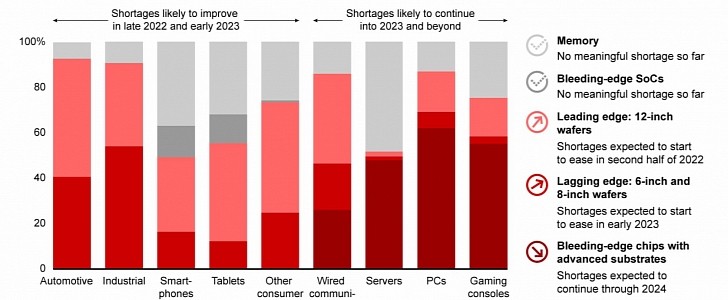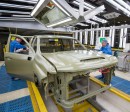If it’s not clear already, the chip shortage continues to wreak havoc in the entire world, and pretty much every industry out there still has a hard time dealing with the super-constrained semiconductor inventory.
What’s worse is that nobody knows precisely when the whole thing could come to an end, as the mix of geopolitical tensions, the lack of certain materials, as well as the government restrictions in certain regions all make it nearly impossible to speed up the recovery.
But recent research from Bain & Company comes with both a horror forecast for certain industry sectors and pretty good news for carmakers.
In just a few words, Bain & Company believes the recovery following the chip crisis wouldn’t happen at the same time for all companies out there. It all depends on the industry and the chip type they’re using.
The research anticipates a full recovery at some point in 2024 or even later, which means we’re still at least two years away from the end of the chip shortage. On the other hand, some industry sectors will start their recovery as soon as 2022, with the whole thing to speed up throughout 2023.
More specifically, automotive and industrial companies, which use 6-inch, 8-inch, and 12-inch wafers, will see improvements in terms of chip inventory in late 2022, mostly thanks to new fabs coming online. Smartphone and tablet producers will also get the first taste of the sweet recovery in 2023 as the supply for the same chips is improving.
But on the other hand, companies that rely on bleeding-edge wafers, which typically include gaming consoles and computer servers, would continue to struggle until at least 2024. This is because their chip designs require additional investments for a rapid capacity increase, so it’s hard to believe that fabs would end up spending aggressively on boosting their production in the short term.
But recent research from Bain & Company comes with both a horror forecast for certain industry sectors and pretty good news for carmakers.
In just a few words, Bain & Company believes the recovery following the chip crisis wouldn’t happen at the same time for all companies out there. It all depends on the industry and the chip type they’re using.
The research anticipates a full recovery at some point in 2024 or even later, which means we’re still at least two years away from the end of the chip shortage. On the other hand, some industry sectors will start their recovery as soon as 2022, with the whole thing to speed up throughout 2023.
More specifically, automotive and industrial companies, which use 6-inch, 8-inch, and 12-inch wafers, will see improvements in terms of chip inventory in late 2022, mostly thanks to new fabs coming online. Smartphone and tablet producers will also get the first taste of the sweet recovery in 2023 as the supply for the same chips is improving.
But on the other hand, companies that rely on bleeding-edge wafers, which typically include gaming consoles and computer servers, would continue to struggle until at least 2024. This is because their chip designs require additional investments for a rapid capacity increase, so it’s hard to believe that fabs would end up spending aggressively on boosting their production in the short term.






